Comprehensive Report: International Finance Management Analysis
VerifiedAdded on 2020/03/07
|16
|4538
|74
Report
AI Summary
This report delves into various aspects of international financial management. It begins by analyzing the returns from investments in Argentina, considering the impact of high inflation rates and exchange rate fluctuations. The report then examines carry trade strategies, highlighting the associated risks and the Uncovered Interest Parity (UIP) theory. It explores hedging techniques using derivatives to mitigate currency risks for beef importers. The report further investigates triangular arbitrage, its implications on currency market volatility and stability, and the relationship between inflation and forward rates. It also explains the benefits and costs of range forward or collar arrangements. Finally, the report discusses the impact of the Brexit vote on currency and stock prices, and analyzes the ethical considerations surrounding the Transatlantic Trade and Investment Partnership (TTIP) and its impact on employment creation.
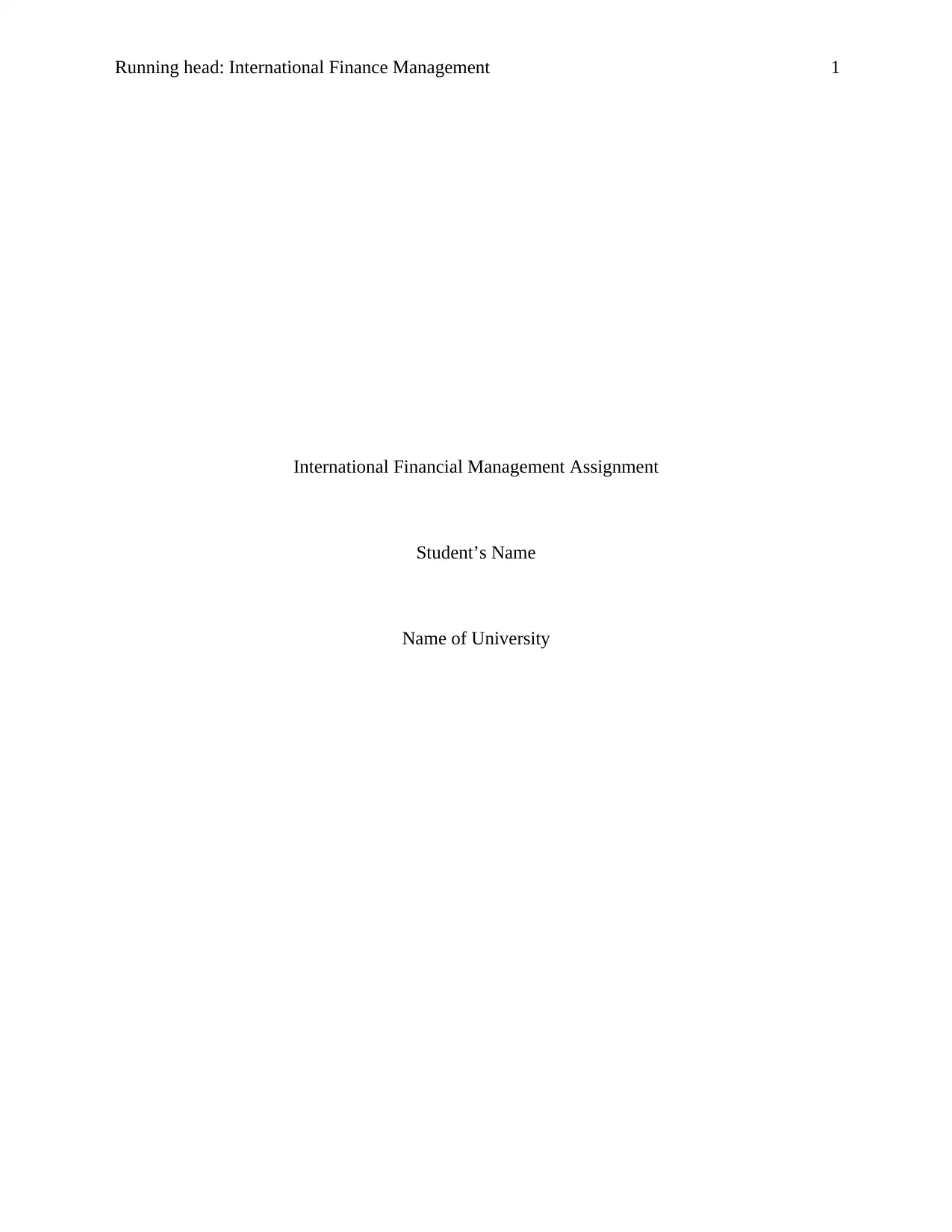
Running head: International Finance Management 1
International Financial Management Assignment
Student’s Name
Name of University
International Financial Management Assignment
Student’s Name
Name of University
Paraphrase This Document
Need a fresh take? Get an instant paraphrase of this document with our AI Paraphraser
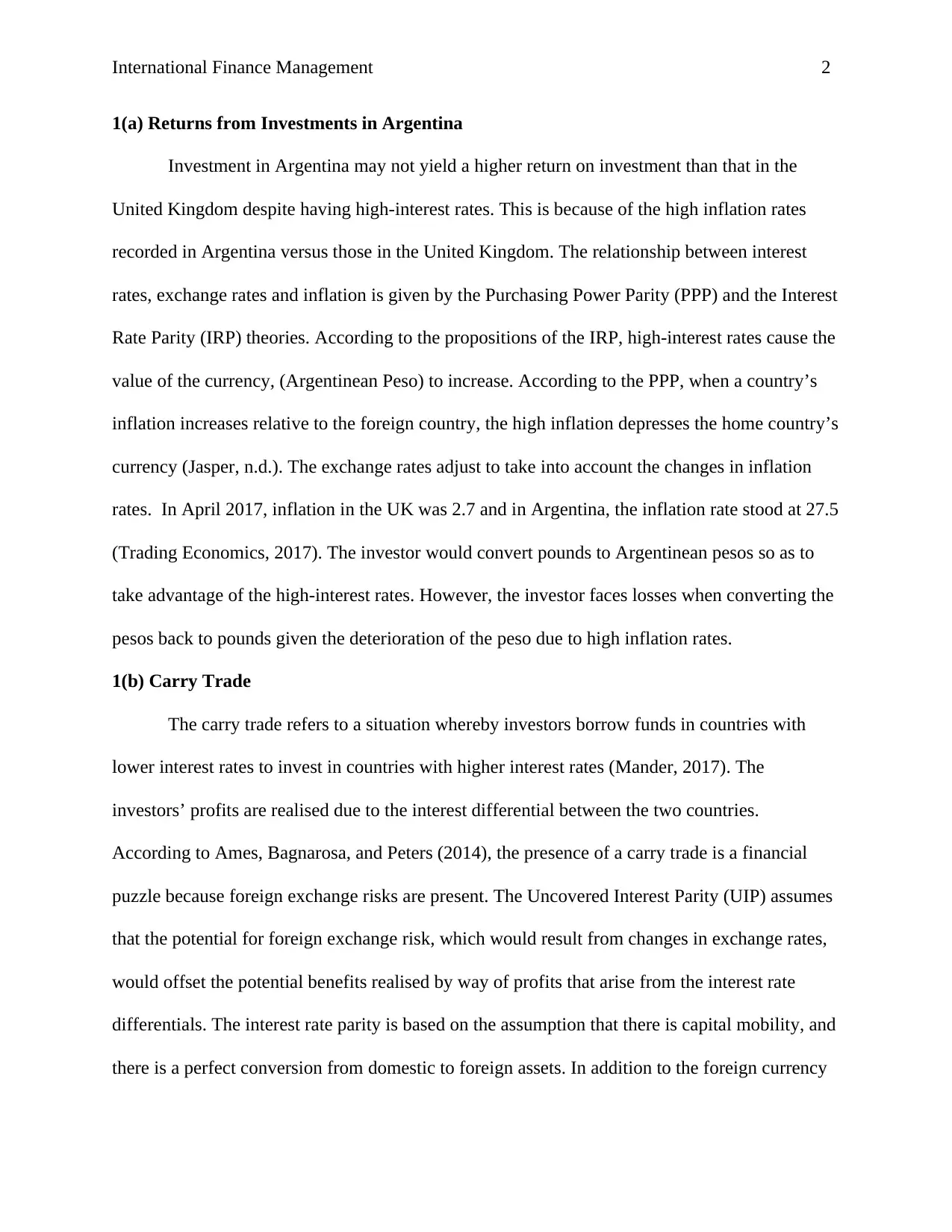
International Finance Management 2
1(a) Returns from Investments in Argentina
Investment in Argentina may not yield a higher return on investment than that in the
United Kingdom despite having high-interest rates. This is because of the high inflation rates
recorded in Argentina versus those in the United Kingdom. The relationship between interest
rates, exchange rates and inflation is given by the Purchasing Power Parity (PPP) and the Interest
Rate Parity (IRP) theories. According to the propositions of the IRP, high-interest rates cause the
value of the currency, (Argentinean Peso) to increase. According to the PPP, when a country’s
inflation increases relative to the foreign country, the high inflation depresses the home country’s
currency (Jasper, n.d.). The exchange rates adjust to take into account the changes in inflation
rates. In April 2017, inflation in the UK was 2.7 and in Argentina, the inflation rate stood at 27.5
(Trading Economics, 2017). The investor would convert pounds to Argentinean pesos so as to
take advantage of the high-interest rates. However, the investor faces losses when converting the
pesos back to pounds given the deterioration of the peso due to high inflation rates.
1(b) Carry Trade
The carry trade refers to a situation whereby investors borrow funds in countries with
lower interest rates to invest in countries with higher interest rates (Mander, 2017). The
investors’ profits are realised due to the interest differential between the two countries.
According to Ames, Bagnarosa, and Peters (2014), the presence of a carry trade is a financial
puzzle because foreign exchange risks are present. The Uncovered Interest Parity (UIP) assumes
that the potential for foreign exchange risk, which would result from changes in exchange rates,
would offset the potential benefits realised by way of profits that arise from the interest rate
differentials. The interest rate parity is based on the assumption that there is capital mobility, and
there is a perfect conversion from domestic to foreign assets. In addition to the foreign currency
1(a) Returns from Investments in Argentina
Investment in Argentina may not yield a higher return on investment than that in the
United Kingdom despite having high-interest rates. This is because of the high inflation rates
recorded in Argentina versus those in the United Kingdom. The relationship between interest
rates, exchange rates and inflation is given by the Purchasing Power Parity (PPP) and the Interest
Rate Parity (IRP) theories. According to the propositions of the IRP, high-interest rates cause the
value of the currency, (Argentinean Peso) to increase. According to the PPP, when a country’s
inflation increases relative to the foreign country, the high inflation depresses the home country’s
currency (Jasper, n.d.). The exchange rates adjust to take into account the changes in inflation
rates. In April 2017, inflation in the UK was 2.7 and in Argentina, the inflation rate stood at 27.5
(Trading Economics, 2017). The investor would convert pounds to Argentinean pesos so as to
take advantage of the high-interest rates. However, the investor faces losses when converting the
pesos back to pounds given the deterioration of the peso due to high inflation rates.
1(b) Carry Trade
The carry trade refers to a situation whereby investors borrow funds in countries with
lower interest rates to invest in countries with higher interest rates (Mander, 2017). The
investors’ profits are realised due to the interest differential between the two countries.
According to Ames, Bagnarosa, and Peters (2014), the presence of a carry trade is a financial
puzzle because foreign exchange risks are present. The Uncovered Interest Parity (UIP) assumes
that the potential for foreign exchange risk, which would result from changes in exchange rates,
would offset the potential benefits realised by way of profits that arise from the interest rate
differentials. The interest rate parity is based on the assumption that there is capital mobility, and
there is a perfect conversion from domestic to foreign assets. In addition to the foreign currency
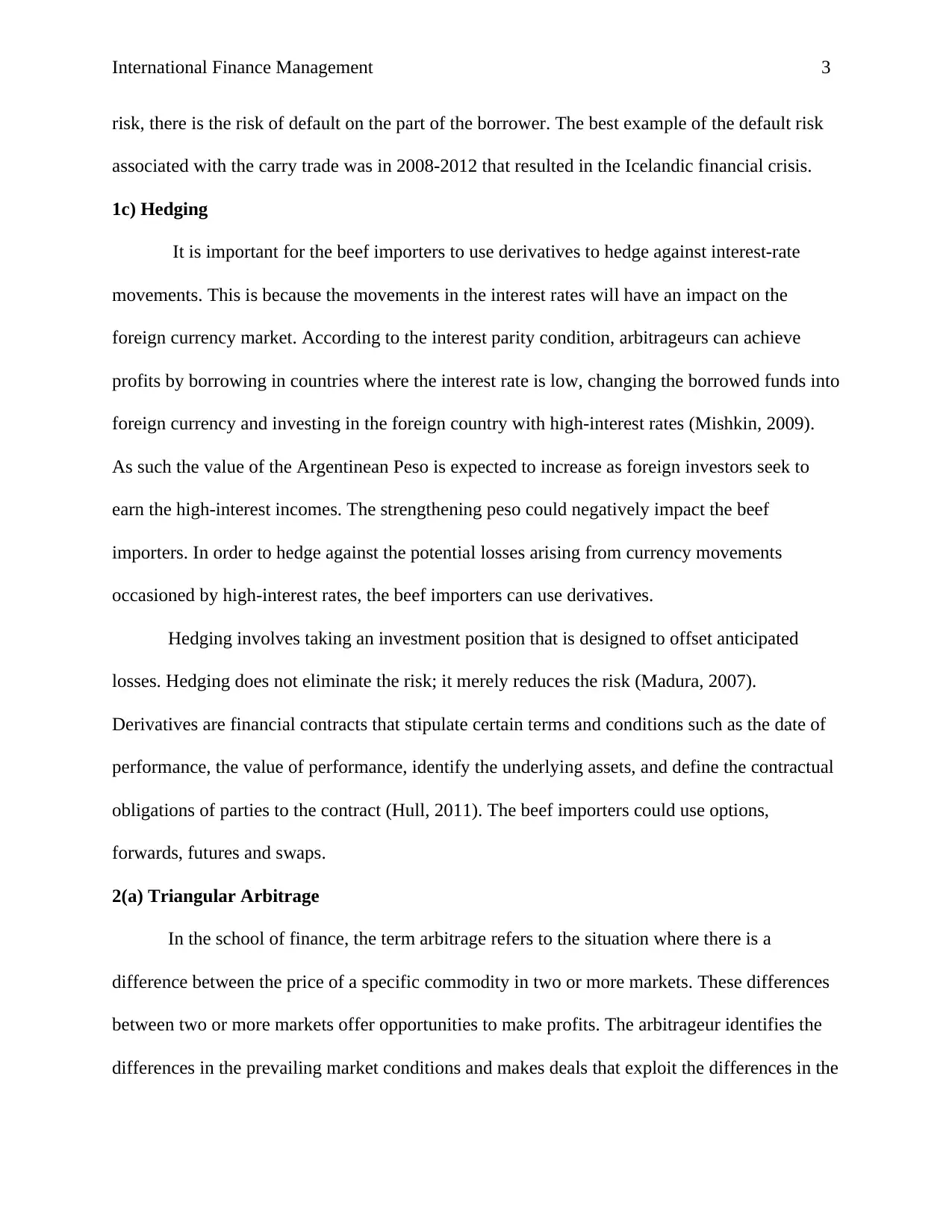
International Finance Management 3
risk, there is the risk of default on the part of the borrower. The best example of the default risk
associated with the carry trade was in 2008-2012 that resulted in the Icelandic financial crisis.
1c) Hedging
It is important for the beef importers to use derivatives to hedge against interest-rate
movements. This is because the movements in the interest rates will have an impact on the
foreign currency market. According to the interest parity condition, arbitrageurs can achieve
profits by borrowing in countries where the interest rate is low, changing the borrowed funds into
foreign currency and investing in the foreign country with high-interest rates (Mishkin, 2009).
As such the value of the Argentinean Peso is expected to increase as foreign investors seek to
earn the high-interest incomes. The strengthening peso could negatively impact the beef
importers. In order to hedge against the potential losses arising from currency movements
occasioned by high-interest rates, the beef importers can use derivatives.
Hedging involves taking an investment position that is designed to offset anticipated
losses. Hedging does not eliminate the risk; it merely reduces the risk (Madura, 2007).
Derivatives are financial contracts that stipulate certain terms and conditions such as the date of
performance, the value of performance, identify the underlying assets, and define the contractual
obligations of parties to the contract (Hull, 2011). The beef importers could use options,
forwards, futures and swaps.
2(a) Triangular Arbitrage
In the school of finance, the term arbitrage refers to the situation where there is a
difference between the price of a specific commodity in two or more markets. These differences
between two or more markets offer opportunities to make profits. The arbitrageur identifies the
differences in the prevailing market conditions and makes deals that exploit the differences in the
risk, there is the risk of default on the part of the borrower. The best example of the default risk
associated with the carry trade was in 2008-2012 that resulted in the Icelandic financial crisis.
1c) Hedging
It is important for the beef importers to use derivatives to hedge against interest-rate
movements. This is because the movements in the interest rates will have an impact on the
foreign currency market. According to the interest parity condition, arbitrageurs can achieve
profits by borrowing in countries where the interest rate is low, changing the borrowed funds into
foreign currency and investing in the foreign country with high-interest rates (Mishkin, 2009).
As such the value of the Argentinean Peso is expected to increase as foreign investors seek to
earn the high-interest incomes. The strengthening peso could negatively impact the beef
importers. In order to hedge against the potential losses arising from currency movements
occasioned by high-interest rates, the beef importers can use derivatives.
Hedging involves taking an investment position that is designed to offset anticipated
losses. Hedging does not eliminate the risk; it merely reduces the risk (Madura, 2007).
Derivatives are financial contracts that stipulate certain terms and conditions such as the date of
performance, the value of performance, identify the underlying assets, and define the contractual
obligations of parties to the contract (Hull, 2011). The beef importers could use options,
forwards, futures and swaps.
2(a) Triangular Arbitrage
In the school of finance, the term arbitrage refers to the situation where there is a
difference between the price of a specific commodity in two or more markets. These differences
between two or more markets offer opportunities to make profits. The arbitrageur identifies the
differences in the prevailing market conditions and makes deals that exploit the differences in the
⊘ This is a preview!⊘
Do you want full access?
Subscribe today to unlock all pages.

Trusted by 1+ million students worldwide

International Finance Management 4
market. The profit is the difference between the buying price and selling price prevailing in the
two markets (He, 2013). The most common type of arbitrage in the currency market is the two
point arbitrage. This occurs where there is a negative spread between the ask price and the bid
price (Forex Capital Markets, 2017). Triangular arbitrage also referred to as cross-currency
arbitrage involves more than two currencies. The relationship between the three currencies is
given as
Currency 1/ Currency 2 x Currency 3/Currency 1 = Currency 3/Currency 2
USDARS x GBPUSD= GBPARS
14.25 x 1.3= 18.53 ≠ 19.5
Where the equation does not hold then a situation of arbitrage exists. Given that there is a
pricing discrepancy, then the condition of triangular arbitrage exists.
2(b) Implication of Triangular Arbitrage
The implications of triangular arbitrage are two- fold. Firstly, the transactions can lead
to volatility in the foreign exchange markets. Using technology, market participants (mostly
banks) are able to identify foreign exchange differentials use arbitrage to capitalise on the
differences. This entails moving large amounts of currency in and out of different markets then
revising the situation a few minutes later. The movement from one currency to another results in
sudden changes in prices and creates volatility in the currency markets (Fenn, Howison,
McDonald, Williams, & Johnson, 2009). The second implication of triangular arbitrage is
counter to that given by Fenn et al., (2009). According to Madura (2007), triangular arbitrage
creates stability in the currency markets. In situations where small price discrepancies are not
identified quickly, the discrepancies continue to increase and become more pronounced. As a
result, firms and individuals who transact in foreign currency spend more time searching for the
market. The profit is the difference between the buying price and selling price prevailing in the
two markets (He, 2013). The most common type of arbitrage in the currency market is the two
point arbitrage. This occurs where there is a negative spread between the ask price and the bid
price (Forex Capital Markets, 2017). Triangular arbitrage also referred to as cross-currency
arbitrage involves more than two currencies. The relationship between the three currencies is
given as
Currency 1/ Currency 2 x Currency 3/Currency 1 = Currency 3/Currency 2
USDARS x GBPUSD= GBPARS
14.25 x 1.3= 18.53 ≠ 19.5
Where the equation does not hold then a situation of arbitrage exists. Given that there is a
pricing discrepancy, then the condition of triangular arbitrage exists.
2(b) Implication of Triangular Arbitrage
The implications of triangular arbitrage are two- fold. Firstly, the transactions can lead
to volatility in the foreign exchange markets. Using technology, market participants (mostly
banks) are able to identify foreign exchange differentials use arbitrage to capitalise on the
differences. This entails moving large amounts of currency in and out of different markets then
revising the situation a few minutes later. The movement from one currency to another results in
sudden changes in prices and creates volatility in the currency markets (Fenn, Howison,
McDonald, Williams, & Johnson, 2009). The second implication of triangular arbitrage is
counter to that given by Fenn et al., (2009). According to Madura (2007), triangular arbitrage
creates stability in the currency markets. In situations where small price discrepancies are not
identified quickly, the discrepancies continue to increase and become more pronounced. As a
result, firms and individuals who transact in foreign currency spend more time searching for the
Paraphrase This Document
Need a fresh take? Get an instant paraphrase of this document with our AI Paraphraser
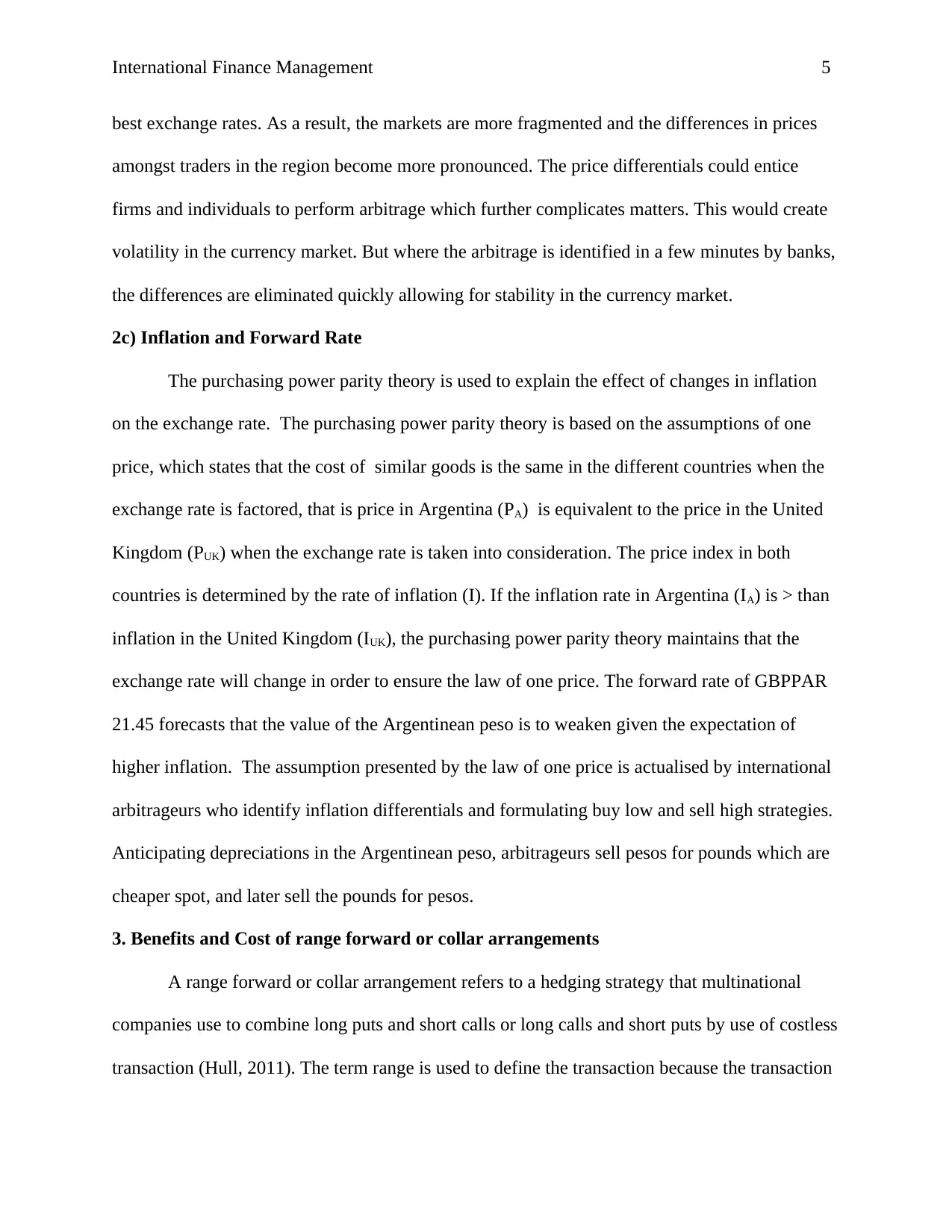
International Finance Management 5
best exchange rates. As a result, the markets are more fragmented and the differences in prices
amongst traders in the region become more pronounced. The price differentials could entice
firms and individuals to perform arbitrage which further complicates matters. This would create
volatility in the currency market. But where the arbitrage is identified in a few minutes by banks,
the differences are eliminated quickly allowing for stability in the currency market.
2c) Inflation and Forward Rate
The purchasing power parity theory is used to explain the effect of changes in inflation
on the exchange rate. The purchasing power parity theory is based on the assumptions of one
price, which states that the cost of similar goods is the same in the different countries when the
exchange rate is factored, that is price in Argentina (PA) is equivalent to the price in the United
Kingdom (PUK) when the exchange rate is taken into consideration. The price index in both
countries is determined by the rate of inflation (I). If the inflation rate in Argentina (IA) is > than
inflation in the United Kingdom (IUK), the purchasing power parity theory maintains that the
exchange rate will change in order to ensure the law of one price. The forward rate of GBPPAR
21.45 forecasts that the value of the Argentinean peso is to weaken given the expectation of
higher inflation. The assumption presented by the law of one price is actualised by international
arbitrageurs who identify inflation differentials and formulating buy low and sell high strategies.
Anticipating depreciations in the Argentinean peso, arbitrageurs sell pesos for pounds which are
cheaper spot, and later sell the pounds for pesos.
3. Benefits and Cost of range forward or collar arrangements
A range forward or collar arrangement refers to a hedging strategy that multinational
companies use to combine long puts and short calls or long calls and short puts by use of costless
transaction (Hull, 2011). The term range is used to define the transaction because the transaction
best exchange rates. As a result, the markets are more fragmented and the differences in prices
amongst traders in the region become more pronounced. The price differentials could entice
firms and individuals to perform arbitrage which further complicates matters. This would create
volatility in the currency market. But where the arbitrage is identified in a few minutes by banks,
the differences are eliminated quickly allowing for stability in the currency market.
2c) Inflation and Forward Rate
The purchasing power parity theory is used to explain the effect of changes in inflation
on the exchange rate. The purchasing power parity theory is based on the assumptions of one
price, which states that the cost of similar goods is the same in the different countries when the
exchange rate is factored, that is price in Argentina (PA) is equivalent to the price in the United
Kingdom (PUK) when the exchange rate is taken into consideration. The price index in both
countries is determined by the rate of inflation (I). If the inflation rate in Argentina (IA) is > than
inflation in the United Kingdom (IUK), the purchasing power parity theory maintains that the
exchange rate will change in order to ensure the law of one price. The forward rate of GBPPAR
21.45 forecasts that the value of the Argentinean peso is to weaken given the expectation of
higher inflation. The assumption presented by the law of one price is actualised by international
arbitrageurs who identify inflation differentials and formulating buy low and sell high strategies.
Anticipating depreciations in the Argentinean peso, arbitrageurs sell pesos for pounds which are
cheaper spot, and later sell the pounds for pesos.
3. Benefits and Cost of range forward or collar arrangements
A range forward or collar arrangement refers to a hedging strategy that multinational
companies use to combine long puts and short calls or long calls and short puts by use of costless
transaction (Hull, 2011). The term range is used to define the transaction because the transaction

International Finance Management 6
has the same strike price. Given that the company imports beef and has to make payments in
dollars, it follows that they need to sell sterling (buy dollars). The importer would be in a loss
position if the value of the dollar increases, as they would require more sterling pounds to buy
dollars. Combining put and call options would allow the importer to formulate a zero-cost range
contract.
Expiry in One Year: The importer buys a put at 70.5 and sells the call at 70.8. If at the
expiry of the period the pound has weakened to a spot rate that is more than 70.5, the importer
exercises the put option and sells the pound at 70.5. The call option is left to expire. However, if
the spot rate is below 70.8, the call option is exercised while the put option is allowed to expire.
If the pound 70.5 and 70.8 both the put and call options are allowed to expire.
The range forward contracts have benefits that include protection against unfavourable
currency fluctuations, availability in a large variety of currencies, and are flexible given that the
floor rate and ceiling rate are designed to meet the investor’s needs. However, the importer does
not receive benefits from favourable currency movements, and there are termination costs.
4(a) Brexit Vote
In the Efficient Market Hypothesis put forward by Fama in 1970, the prices of stocks
reflect all the information that is available. According to this theory, movements in the prices of
stocks are occasioned by the availability of information. Prior, to the Brexit vote, there was
uncertainty about Britain leaving or staying. This uncertainty, the fears of a hard Brexit, and the
need to be cautious lead to the downslide in the value of the pound and the FTSE 100
(Cunningham, 2016). The changes in the value of the currency and the FTSE100 after the vote
are according to the Efficient Market Hypothesis due to changes in information and underlying
factors (Bruggen, 2016). Numerous researchers have shown that underlying factors that include
has the same strike price. Given that the company imports beef and has to make payments in
dollars, it follows that they need to sell sterling (buy dollars). The importer would be in a loss
position if the value of the dollar increases, as they would require more sterling pounds to buy
dollars. Combining put and call options would allow the importer to formulate a zero-cost range
contract.
Expiry in One Year: The importer buys a put at 70.5 and sells the call at 70.8. If at the
expiry of the period the pound has weakened to a spot rate that is more than 70.5, the importer
exercises the put option and sells the pound at 70.5. The call option is left to expire. However, if
the spot rate is below 70.8, the call option is exercised while the put option is allowed to expire.
If the pound 70.5 and 70.8 both the put and call options are allowed to expire.
The range forward contracts have benefits that include protection against unfavourable
currency fluctuations, availability in a large variety of currencies, and are flexible given that the
floor rate and ceiling rate are designed to meet the investor’s needs. However, the importer does
not receive benefits from favourable currency movements, and there are termination costs.
4(a) Brexit Vote
In the Efficient Market Hypothesis put forward by Fama in 1970, the prices of stocks
reflect all the information that is available. According to this theory, movements in the prices of
stocks are occasioned by the availability of information. Prior, to the Brexit vote, there was
uncertainty about Britain leaving or staying. This uncertainty, the fears of a hard Brexit, and the
need to be cautious lead to the downslide in the value of the pound and the FTSE 100
(Cunningham, 2016). The changes in the value of the currency and the FTSE100 after the vote
are according to the Efficient Market Hypothesis due to changes in information and underlying
factors (Bruggen, 2016). Numerous researchers have shown that underlying factors that include
⊘ This is a preview!⊘
Do you want full access?
Subscribe today to unlock all pages.

Trusted by 1+ million students worldwide
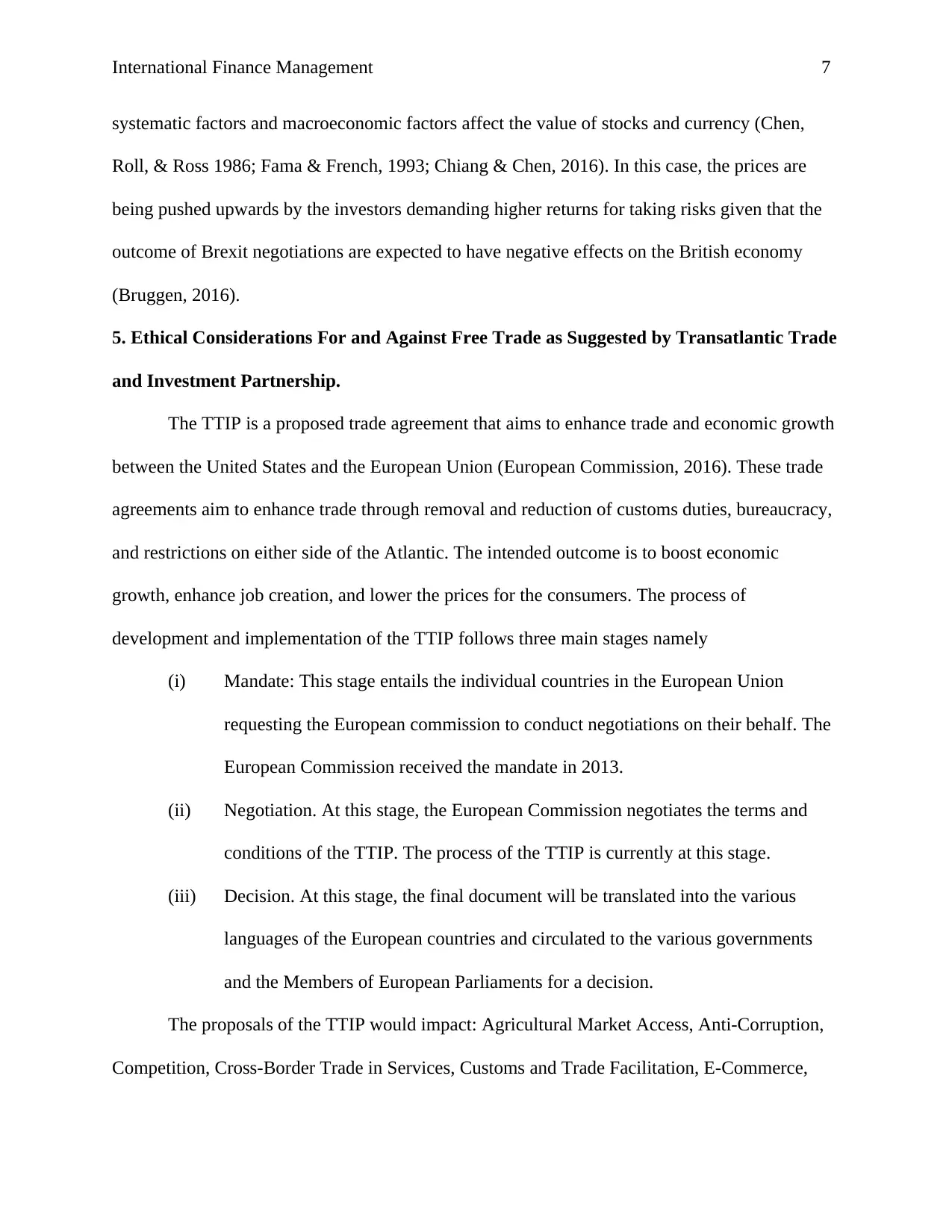
International Finance Management 7
systematic factors and macroeconomic factors affect the value of stocks and currency (Chen,
Roll, & Ross 1986; Fama & French, 1993; Chiang & Chen, 2016). In this case, the prices are
being pushed upwards by the investors demanding higher returns for taking risks given that the
outcome of Brexit negotiations are expected to have negative effects on the British economy
(Bruggen, 2016).
5. Ethical Considerations For and Against Free Trade as Suggested by Transatlantic Trade
and Investment Partnership.
The TTIP is a proposed trade agreement that aims to enhance trade and economic growth
between the United States and the European Union (European Commission, 2016). These trade
agreements aim to enhance trade through removal and reduction of customs duties, bureaucracy,
and restrictions on either side of the Atlantic. The intended outcome is to boost economic
growth, enhance job creation, and lower the prices for the consumers. The process of
development and implementation of the TTIP follows three main stages namely
(i) Mandate: This stage entails the individual countries in the European Union
requesting the European commission to conduct negotiations on their behalf. The
European Commission received the mandate in 2013.
(ii) Negotiation. At this stage, the European Commission negotiates the terms and
conditions of the TTIP. The process of the TTIP is currently at this stage.
(iii) Decision. At this stage, the final document will be translated into the various
languages of the European countries and circulated to the various governments
and the Members of European Parliaments for a decision.
The proposals of the TTIP would impact: Agricultural Market Access, Anti-Corruption,
Competition, Cross-Border Trade in Services, Customs and Trade Facilitation, E-Commerce,
systematic factors and macroeconomic factors affect the value of stocks and currency (Chen,
Roll, & Ross 1986; Fama & French, 1993; Chiang & Chen, 2016). In this case, the prices are
being pushed upwards by the investors demanding higher returns for taking risks given that the
outcome of Brexit negotiations are expected to have negative effects on the British economy
(Bruggen, 2016).
5. Ethical Considerations For and Against Free Trade as Suggested by Transatlantic Trade
and Investment Partnership.
The TTIP is a proposed trade agreement that aims to enhance trade and economic growth
between the United States and the European Union (European Commission, 2016). These trade
agreements aim to enhance trade through removal and reduction of customs duties, bureaucracy,
and restrictions on either side of the Atlantic. The intended outcome is to boost economic
growth, enhance job creation, and lower the prices for the consumers. The process of
development and implementation of the TTIP follows three main stages namely
(i) Mandate: This stage entails the individual countries in the European Union
requesting the European commission to conduct negotiations on their behalf. The
European Commission received the mandate in 2013.
(ii) Negotiation. At this stage, the European Commission negotiates the terms and
conditions of the TTIP. The process of the TTIP is currently at this stage.
(iii) Decision. At this stage, the final document will be translated into the various
languages of the European countries and circulated to the various governments
and the Members of European Parliaments for a decision.
The proposals of the TTIP would impact: Agricultural Market Access, Anti-Corruption,
Competition, Cross-Border Trade in Services, Customs and Trade Facilitation, E-Commerce,
Paraphrase This Document
Need a fresh take? Get an instant paraphrase of this document with our AI Paraphraser

International Finance Management 8
Energy and Raw Materials, Financial Services, Investment Protections, Intellectual Property
Rights, Legal and Institutional , Market Access/Industrial Goods, Procurement, Regulatory
Coherence, Regulatory Cooperation, Rules of Origin, Small and Medium Sized Enterprises,
State-Owned Enterprises, Sanitary and Phytosanitary Measures, State-to-State Dispute
Settlement, Subsidies, Sustainable Development, Labour, Environment, Technical Barriers to
Trade, Telecom, Sectors, Textiles and Apparels and Trade Remedies (Maler, 2016). Given the
wide-ranging nature of the proposals in the TTIP, it is only natural that there will be ethical
considerations faced by various stakeholders particularly multinationals.
Ethical Consideration for TTIP
(i) Impact on Employment Creation. The framework for TTIP proposes the removal of
tariffs, bureaucratic process, reduces restrictions that would constrain investment. The
aim of these is to enhance the process of importation, exports and investments
between Europe and America. This would be advantageous for both sides as it would
result in job creation (Office of the United States Trade Representative, n.d.).
Additionally, it is expected that the income of the average household would increase
by up to 600 Euros per year (Brakman, Kohl, & Marrewijk, 2015).
(ii) Impact on the Consumers. The proposals in TTIP will lead to an opening up of
markets for goods and services. The consumers will be able to access a wider variety
and higher quality of goods and services at cheaper prices (Zetche, 2016).
(iii) Dispute Resolution. The TTIP will give a framework for the resolution of disputes
between investors in this case multinationals and governments. The TTIP ensures that
the rights of the investors are protected while addressing the concerns of the
governments and their citizens.
Energy and Raw Materials, Financial Services, Investment Protections, Intellectual Property
Rights, Legal and Institutional , Market Access/Industrial Goods, Procurement, Regulatory
Coherence, Regulatory Cooperation, Rules of Origin, Small and Medium Sized Enterprises,
State-Owned Enterprises, Sanitary and Phytosanitary Measures, State-to-State Dispute
Settlement, Subsidies, Sustainable Development, Labour, Environment, Technical Barriers to
Trade, Telecom, Sectors, Textiles and Apparels and Trade Remedies (Maler, 2016). Given the
wide-ranging nature of the proposals in the TTIP, it is only natural that there will be ethical
considerations faced by various stakeholders particularly multinationals.
Ethical Consideration for TTIP
(i) Impact on Employment Creation. The framework for TTIP proposes the removal of
tariffs, bureaucratic process, reduces restrictions that would constrain investment. The
aim of these is to enhance the process of importation, exports and investments
between Europe and America. This would be advantageous for both sides as it would
result in job creation (Office of the United States Trade Representative, n.d.).
Additionally, it is expected that the income of the average household would increase
by up to 600 Euros per year (Brakman, Kohl, & Marrewijk, 2015).
(ii) Impact on the Consumers. The proposals in TTIP will lead to an opening up of
markets for goods and services. The consumers will be able to access a wider variety
and higher quality of goods and services at cheaper prices (Zetche, 2016).
(iii) Dispute Resolution. The TTIP will give a framework for the resolution of disputes
between investors in this case multinationals and governments. The TTIP ensures that
the rights of the investors are protected while addressing the concerns of the
governments and their citizens.

International Finance Management 9
(iv) Effects on Standards. The TTIP proposes to set standards that address issues such as
e-commerce, digital market rules, intellectual property rights, and competition by
state-owned entities (Sutton, 2015). The standards will harmonise the rules and
regulations in all the countries, creating a fair playing field for all market participants.
Ethical Considerations against TTIP
(i) Market Power Concentration. Research conducted by Vitali, Glattfelder, and
Battiston (2011) indicates that a network of 147 multinationals controls more than
40% of corporate capital. The implementation of TTIP would further enhance the
extra-ordinary market power concentration held by multinationals. This means that
there will be no guarantee of free access to markets or mechanisms to control these
corporations.
(ii) Effect on Democracy. The process of formulation of the TTIP involves various
stakeholders including multinationals. The multinationals have taken a key role in the
development process, putting forward proposals that would enhance their power at
the expense of the citizens. This would ultimately diminish the democratic processes
in the member states (Gallagher, 2017).
(iii) Impact on the Environment. The proposals made in the TTIP significantly lower the
environmental protection standards that are in place particularly in Europe. The
agreement would undermine the actions taken to limit the impact of business on the
climate (Stiglitz. 2016). The changes in the climate have negative effects on both
businesses and individuals with the most profound effects being experienced by the
poor.
(iv) Effects on Standards. The TTIP proposes to set standards that address issues such as
e-commerce, digital market rules, intellectual property rights, and competition by
state-owned entities (Sutton, 2015). The standards will harmonise the rules and
regulations in all the countries, creating a fair playing field for all market participants.
Ethical Considerations against TTIP
(i) Market Power Concentration. Research conducted by Vitali, Glattfelder, and
Battiston (2011) indicates that a network of 147 multinationals controls more than
40% of corporate capital. The implementation of TTIP would further enhance the
extra-ordinary market power concentration held by multinationals. This means that
there will be no guarantee of free access to markets or mechanisms to control these
corporations.
(ii) Effect on Democracy. The process of formulation of the TTIP involves various
stakeholders including multinationals. The multinationals have taken a key role in the
development process, putting forward proposals that would enhance their power at
the expense of the citizens. This would ultimately diminish the democratic processes
in the member states (Gallagher, 2017).
(iii) Impact on the Environment. The proposals made in the TTIP significantly lower the
environmental protection standards that are in place particularly in Europe. The
agreement would undermine the actions taken to limit the impact of business on the
climate (Stiglitz. 2016). The changes in the climate have negative effects on both
businesses and individuals with the most profound effects being experienced by the
poor.
⊘ This is a preview!⊘
Do you want full access?
Subscribe today to unlock all pages.

Trusted by 1+ million students worldwide
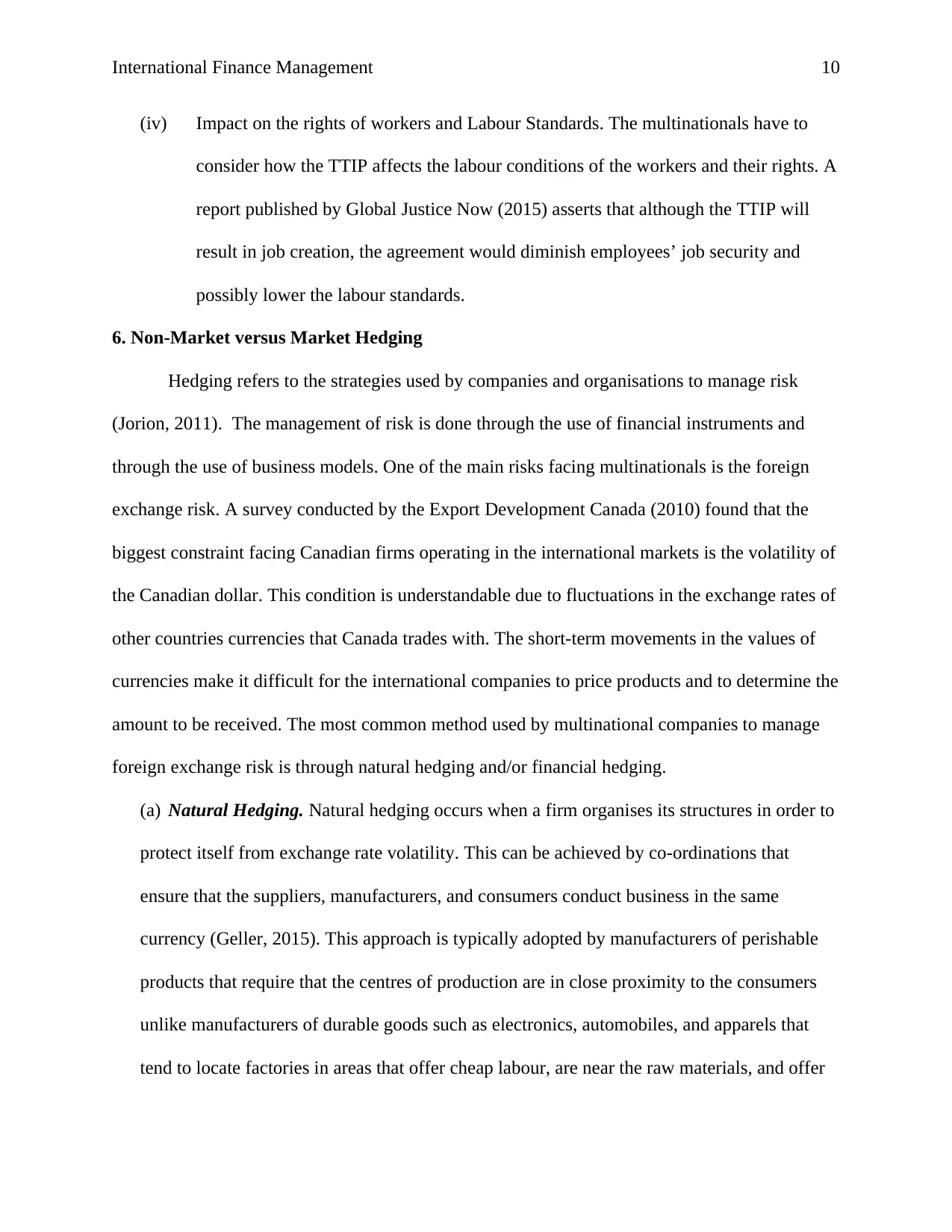
International Finance Management 10
(iv) Impact on the rights of workers and Labour Standards. The multinationals have to
consider how the TTIP affects the labour conditions of the workers and their rights. A
report published by Global Justice Now (2015) asserts that although the TTIP will
result in job creation, the agreement would diminish employees’ job security and
possibly lower the labour standards.
6. Non-Market versus Market Hedging
Hedging refers to the strategies used by companies and organisations to manage risk
(Jorion, 2011). The management of risk is done through the use of financial instruments and
through the use of business models. One of the main risks facing multinationals is the foreign
exchange risk. A survey conducted by the Export Development Canada (2010) found that the
biggest constraint facing Canadian firms operating in the international markets is the volatility of
the Canadian dollar. This condition is understandable due to fluctuations in the exchange rates of
other countries currencies that Canada trades with. The short-term movements in the values of
currencies make it difficult for the international companies to price products and to determine the
amount to be received. The most common method used by multinational companies to manage
foreign exchange risk is through natural hedging and/or financial hedging.
(a) Natural Hedging. Natural hedging occurs when a firm organises its structures in order to
protect itself from exchange rate volatility. This can be achieved by co-ordinations that
ensure that the suppliers, manufacturers, and consumers conduct business in the same
currency (Geller, 2015). This approach is typically adopted by manufacturers of perishable
products that require that the centres of production are in close proximity to the consumers
unlike manufacturers of durable goods such as electronics, automobiles, and apparels that
tend to locate factories in areas that offer cheap labour, are near the raw materials, and offer
(iv) Impact on the rights of workers and Labour Standards. The multinationals have to
consider how the TTIP affects the labour conditions of the workers and their rights. A
report published by Global Justice Now (2015) asserts that although the TTIP will
result in job creation, the agreement would diminish employees’ job security and
possibly lower the labour standards.
6. Non-Market versus Market Hedging
Hedging refers to the strategies used by companies and organisations to manage risk
(Jorion, 2011). The management of risk is done through the use of financial instruments and
through the use of business models. One of the main risks facing multinationals is the foreign
exchange risk. A survey conducted by the Export Development Canada (2010) found that the
biggest constraint facing Canadian firms operating in the international markets is the volatility of
the Canadian dollar. This condition is understandable due to fluctuations in the exchange rates of
other countries currencies that Canada trades with. The short-term movements in the values of
currencies make it difficult for the international companies to price products and to determine the
amount to be received. The most common method used by multinational companies to manage
foreign exchange risk is through natural hedging and/or financial hedging.
(a) Natural Hedging. Natural hedging occurs when a firm organises its structures in order to
protect itself from exchange rate volatility. This can be achieved by co-ordinations that
ensure that the suppliers, manufacturers, and consumers conduct business in the same
currency (Geller, 2015). This approach is typically adopted by manufacturers of perishable
products that require that the centres of production are in close proximity to the consumers
unlike manufacturers of durable goods such as electronics, automobiles, and apparels that
tend to locate factories in areas that offer cheap labour, are near the raw materials, and offer
Paraphrase This Document
Need a fresh take? Get an instant paraphrase of this document with our AI Paraphraser
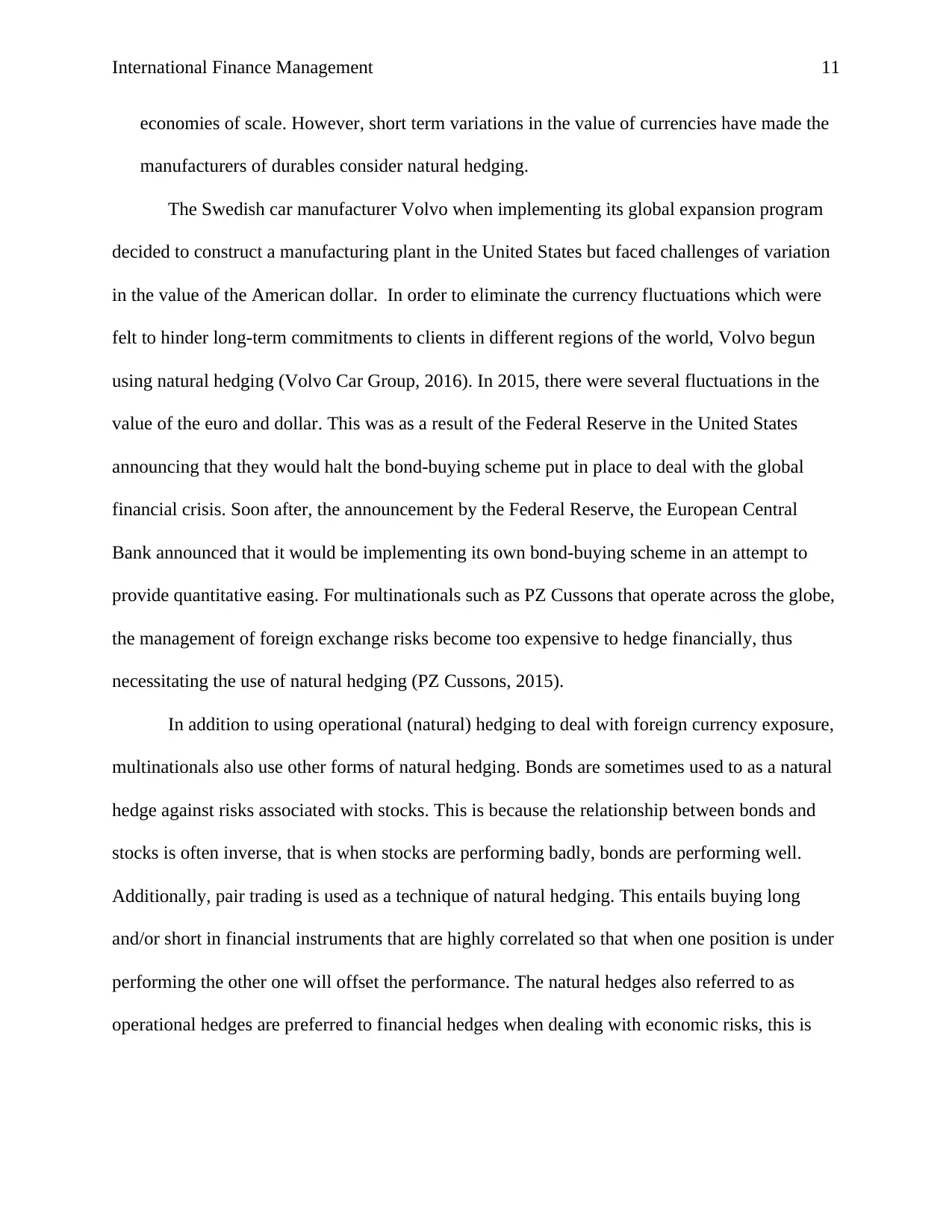
International Finance Management 11
economies of scale. However, short term variations in the value of currencies have made the
manufacturers of durables consider natural hedging.
The Swedish car manufacturer Volvo when implementing its global expansion program
decided to construct a manufacturing plant in the United States but faced challenges of variation
in the value of the American dollar. In order to eliminate the currency fluctuations which were
felt to hinder long-term commitments to clients in different regions of the world, Volvo begun
using natural hedging (Volvo Car Group, 2016). In 2015, there were several fluctuations in the
value of the euro and dollar. This was as a result of the Federal Reserve in the United States
announcing that they would halt the bond-buying scheme put in place to deal with the global
financial crisis. Soon after, the announcement by the Federal Reserve, the European Central
Bank announced that it would be implementing its own bond-buying scheme in an attempt to
provide quantitative easing. For multinationals such as PZ Cussons that operate across the globe,
the management of foreign exchange risks become too expensive to hedge financially, thus
necessitating the use of natural hedging (PZ Cussons, 2015).
In addition to using operational (natural) hedging to deal with foreign currency exposure,
multinationals also use other forms of natural hedging. Bonds are sometimes used to as a natural
hedge against risks associated with stocks. This is because the relationship between bonds and
stocks is often inverse, that is when stocks are performing badly, bonds are performing well.
Additionally, pair trading is used as a technique of natural hedging. This entails buying long
and/or short in financial instruments that are highly correlated so that when one position is under
performing the other one will offset the performance. The natural hedges also referred to as
operational hedges are preferred to financial hedges when dealing with economic risks, this is
economies of scale. However, short term variations in the value of currencies have made the
manufacturers of durables consider natural hedging.
The Swedish car manufacturer Volvo when implementing its global expansion program
decided to construct a manufacturing plant in the United States but faced challenges of variation
in the value of the American dollar. In order to eliminate the currency fluctuations which were
felt to hinder long-term commitments to clients in different regions of the world, Volvo begun
using natural hedging (Volvo Car Group, 2016). In 2015, there were several fluctuations in the
value of the euro and dollar. This was as a result of the Federal Reserve in the United States
announcing that they would halt the bond-buying scheme put in place to deal with the global
financial crisis. Soon after, the announcement by the Federal Reserve, the European Central
Bank announced that it would be implementing its own bond-buying scheme in an attempt to
provide quantitative easing. For multinationals such as PZ Cussons that operate across the globe,
the management of foreign exchange risks become too expensive to hedge financially, thus
necessitating the use of natural hedging (PZ Cussons, 2015).
In addition to using operational (natural) hedging to deal with foreign currency exposure,
multinationals also use other forms of natural hedging. Bonds are sometimes used to as a natural
hedge against risks associated with stocks. This is because the relationship between bonds and
stocks is often inverse, that is when stocks are performing badly, bonds are performing well.
Additionally, pair trading is used as a technique of natural hedging. This entails buying long
and/or short in financial instruments that are highly correlated so that when one position is under
performing the other one will offset the performance. The natural hedges also referred to as
operational hedges are preferred to financial hedges when dealing with economic risks, this is
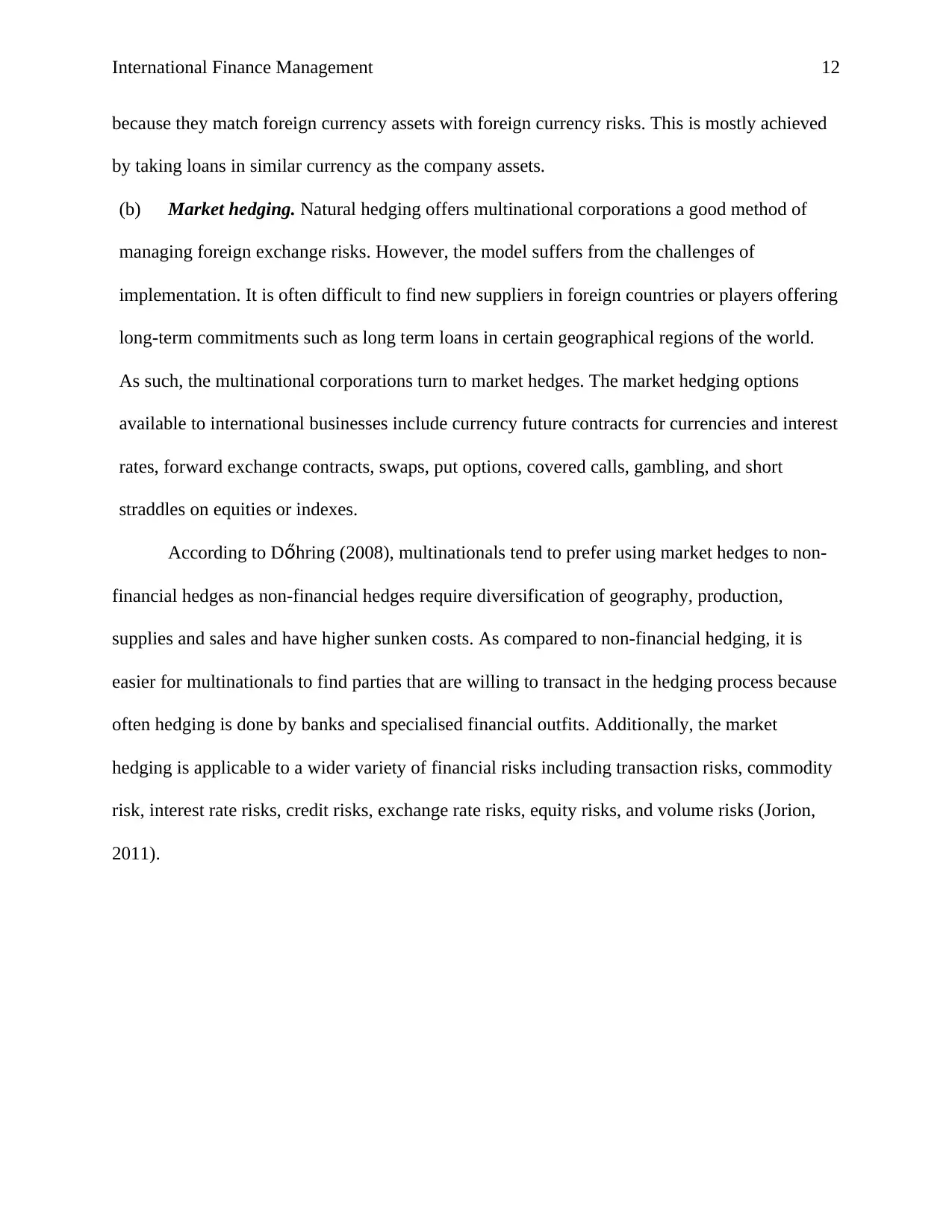
International Finance Management 12
because they match foreign currency assets with foreign currency risks. This is mostly achieved
by taking loans in similar currency as the company assets.
(b) Market hedging. Natural hedging offers multinational corporations a good method of
managing foreign exchange risks. However, the model suffers from the challenges of
implementation. It is often difficult to find new suppliers in foreign countries or players offering
long-term commitments such as long term loans in certain geographical regions of the world.
As such, the multinational corporations turn to market hedges. The market hedging options
available to international businesses include currency future contracts for currencies and interest
rates, forward exchange contracts, swaps, put options, covered calls, gambling, and short
straddles on equities or indexes.
According to Dőhring (2008), multinationals tend to prefer using market hedges to non-
financial hedges as non-financial hedges require diversification of geography, production,
supplies and sales and have higher sunken costs. As compared to non-financial hedging, it is
easier for multinationals to find parties that are willing to transact in the hedging process because
often hedging is done by banks and specialised financial outfits. Additionally, the market
hedging is applicable to a wider variety of financial risks including transaction risks, commodity
risk, interest rate risks, credit risks, exchange rate risks, equity risks, and volume risks (Jorion,
2011).
because they match foreign currency assets with foreign currency risks. This is mostly achieved
by taking loans in similar currency as the company assets.
(b) Market hedging. Natural hedging offers multinational corporations a good method of
managing foreign exchange risks. However, the model suffers from the challenges of
implementation. It is often difficult to find new suppliers in foreign countries or players offering
long-term commitments such as long term loans in certain geographical regions of the world.
As such, the multinational corporations turn to market hedges. The market hedging options
available to international businesses include currency future contracts for currencies and interest
rates, forward exchange contracts, swaps, put options, covered calls, gambling, and short
straddles on equities or indexes.
According to Dőhring (2008), multinationals tend to prefer using market hedges to non-
financial hedges as non-financial hedges require diversification of geography, production,
supplies and sales and have higher sunken costs. As compared to non-financial hedging, it is
easier for multinationals to find parties that are willing to transact in the hedging process because
often hedging is done by banks and specialised financial outfits. Additionally, the market
hedging is applicable to a wider variety of financial risks including transaction risks, commodity
risk, interest rate risks, credit risks, exchange rate risks, equity risks, and volume risks (Jorion,
2011).
⊘ This is a preview!⊘
Do you want full access?
Subscribe today to unlock all pages.

Trusted by 1+ million students worldwide
1 out of 16
Related Documents
Your All-in-One AI-Powered Toolkit for Academic Success.
+13062052269
info@desklib.com
Available 24*7 on WhatsApp / Email
![[object Object]](/_next/static/media/star-bottom.7253800d.svg)
Unlock your academic potential
Copyright © 2020–2025 A2Z Services. All Rights Reserved. Developed and managed by ZUCOL.





